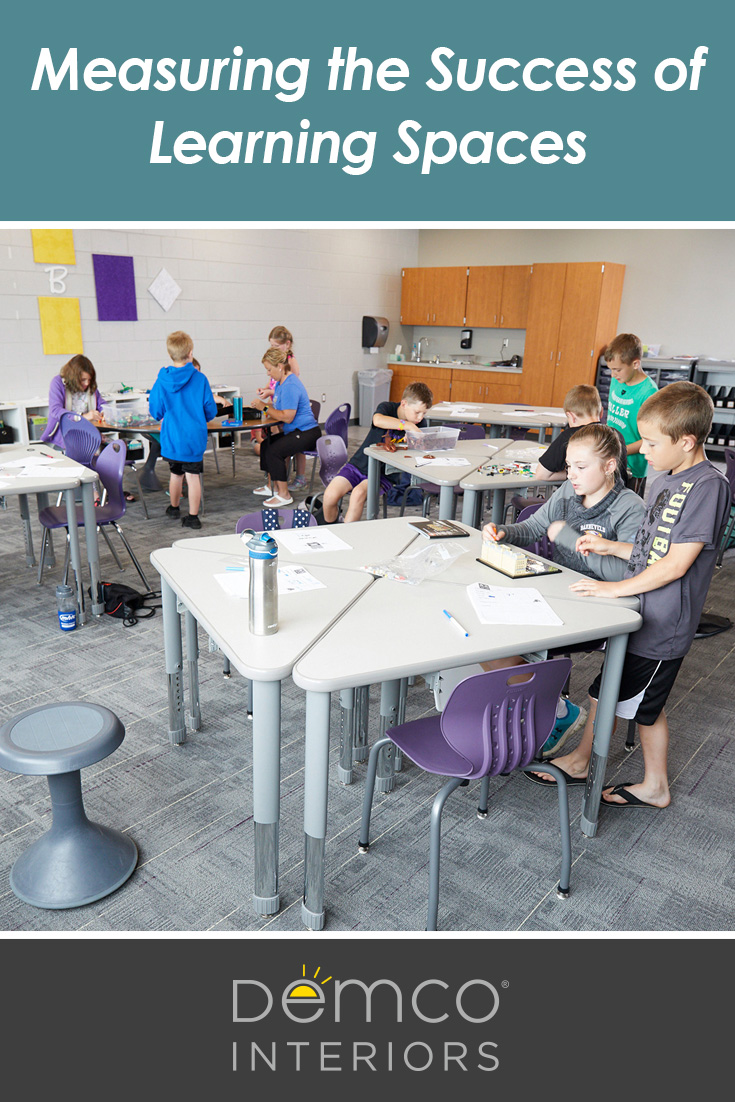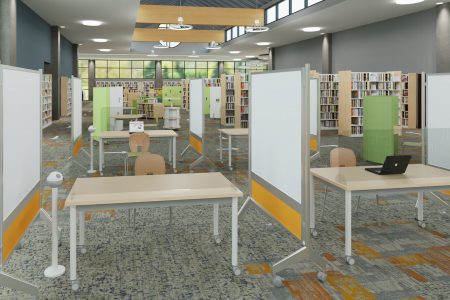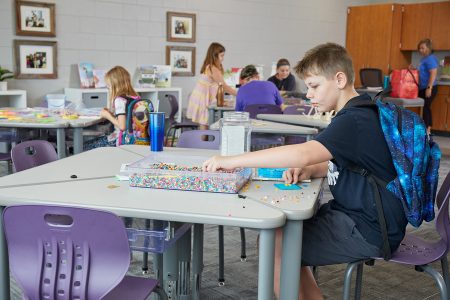 Hint: It’s Not Test Scores
Hint: It’s Not Test Scores
When school and district leaders and design teams embark on redesigning their learning spaces, they know they should set metrics to help determine whether or not their projects are successful. However, for too long, legacy success metrics such as test scores have been used to drive change and innovation in our schools. This use of test scores for measuring complex change has impeded the pace of growth.
As we accelerate down a path of optimizing our learning space design around the country, it is essential that we identify, name, and communicate a broad set of modern success metrics. This will ensure that the work we do to sync our instructional practices, our technology integration, and our learning environments does not get caught in the historic trap of being measured by our test scores. Don’t settle for success metrics that aren’t in line with your mission when redesigning your learning environments.
Why Test Scores Aren’t the Right Way to Evaluate Your Learning Space Design
Using test scores as a success metric for learning space design not only pulls us from the mission of the work, but it also puts us in the position of using a lagging indicator to measure success. Test scores, both formative and summative, measure an aggregation of variables, and this makes it difficult to know if the design of the space was impactful. Instead of using the lagging indicator of test scores, consider moving toward measuring the following leading indicators.
Joy and Engagement
Research in the learning sciences identifies joy (satisfaction) and engagement as key leading indicators of whether the learning environment is rich for growth and academic success. Joy and engagement are prerequisites for long-term success, and the environment in which kids learn impacts these factors. Joy and engagement can be measured informally in the classroom, but they can also be surveyed throughout a school or district. Measure what matters.
Classroom teachers should also be measuring the following three areas, which can be coupled with measuring joy and engagement.
- Classroom Movement
The research is clear that productive movement (standing in the back listening, using a standing desk, or using active seating) in the classroom bolsters growth and supports the overall needs of students. Does your classroom design honor this need? Do you promote movement as a positive force in keeping students focused, on-task, alert, and in the learning space more often? - Active Learning
Teachers should also consider how learning space design, when in sync with instructional design, can add active learning minutes to every section of the day. Active learning includes time when students are collaborating and creating, as well as time when they are in a position in the room that matches their individualized work in that moment. If the majority of your students feel as though they are active in their learning as opposed to passive receivers of information, it is an indication that your classroom design has positively bent instructional design away from traditional methods. - Classroom Management and Behavior Issues
Classroom management and behavior issues in classrooms are often reduced over time with modern space design. Teachers and leaders should be looking at these numbers with close attention to subgroups that have been underserved with traditional learning spaces.
Stress and Anxiety on Students
All spaces that we enter either lower or raise our levels of stress and anxiety. If we are looking for metrics of success around learning spaces, we should include data about how our spaces impact the physical and mental health of our students.
We are in an age of peak stress for students. We see this validated through surveys and we also see this validated through student actions: self-medicating, chronic stress symptoms, and self-harm. It is our responsibility to proactively work to design spaces that heal and support our students in these critical areas. Schools that measure these factors with quality social-emotional learning surveys are seeing that intentionally designed spaces support the mental health of students.
Well-Being of Teachers
For more than 180 days per year, a teacher’s office is their classroom. This space needs to promote wellness not only for students, but also for the teacher who is facilitating student learning.
At times, teachers sacrifice their own health to design spaces that support students, so it is important to make teacher wellness a priority. This requires designing spaces with teachers and not for them, as well as providing some latitude for their individual needs. Placing every educator in a standardized classroom is not healthy for them — learning space design should optimize the individual energy, creativity, and passion of our teachers. And when we measure teacher satisfaction through surveys, it sends a message that they are valued and allows school leaders to see the impact of space on their essential human resources.
Positive Learning Energy
All spaces have an inherent energy that is shaped by their design. The color of the walls, the artifacts that fill the space, how the space is organized, and any negative or unfilled areas can determine the energy of a space.
Certainly, people are the greatest factor affecting the long-term energy in a learning space. But even the people with the most energy to bring to the space are fighting an uphill battle if they aren’t working in spaces that are primed for their enthusiasm. Don’t let the space impair the student growth that can come from being surrounded by positive learning energy.
Measure the natural energy of a space, and then work to push it into a more positive frame. The data collection here is qualitative, and it requires that we ask a sample of individuals about their perception of the space through a short series of questions.
Natural Light, Air Quality, and Acoustics
From research, we also know that there are three major elements that can affect the success of your learning spaces. These may or may not be within the teacher or school leader’s control, but they can be measured. Optimal standards around these areas exist, and schools should be observing how individual learning spaces compare to standards for light, sound, and air quality.
- Look for ways to maximize the amount of natural light in your current and new classrooms to maximize learning. You should also be looking to vary lighting in classrooms to avoid the stress and strain that long-term exposure to fluorescent lighting puts on the eye.
- Recent studies have shown how air purification can positively impact all students, and we should be looking for ways to support our students in this area.
- Acoustics are an important part of the learning experience. The way that we design rooms, coupled with intentional effort from the teacher, can help students hear teachers without repetition and support an atmosphere of collaboration in the classroom.
Community Feedback
As you begin to change your learning spaces, be sure to communicate your mission clearly and consistently to your community. Begin a campaign to share the space changes that are happening. Once this begins, continually measure the questions and feedback that you receive from students, parents, and the community.
Learning space design is a journey, and it is essential to bring the community on this journey from pilot to proficiency. Missing this metric can create a blind spot for schools and districts looking for both formative and summative feedback about how their work resonates beyond the school.
The Importance of Measuring the Impact of Your Learning Space Design
Measuring success is complex. It is always easier to look at a few test scores as the answer to the question, but school leaders who want to truly showcase the impact of their new learning space design should venture into this portfolio of metrics to begin to really see how their work supports teachers and students throughout their school and district.
Dr. Robert Dillon
Latest posts by Dr. Robert Dillon (see all)
- How to Manage Your Active Classroom - April 22, 2020
- Answers to Your Questions About Effective Library and Classroom Design - April 2, 2020
- How to Measure the Success of Your New Learning Space Design - March 3, 2020
- How to Get Your Community and Staff Invested in Redesigning Your Learning Spaces - January 13, 2020
- 3 Ingredients of Active Learning Spaces - October 16, 2019




